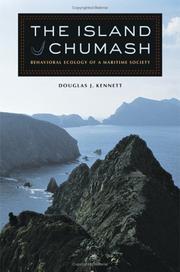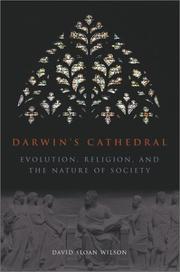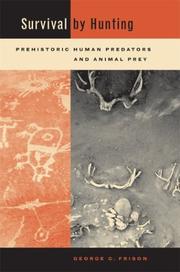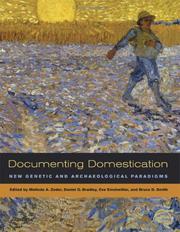| Listing 1 - 10 of 10 |
Sort by
|
Book
ISBN: 9780748678679 9780748678693 0748678670 9780748678662 0748678662 0748678662 9780748678662 0748678697 1474430961 1474431208 Year: 2017 Publisher: Edinburgh Edinburgh University Press
Abstract | Keywords | Export | Availability | Bookmark
 Loading...
Loading...Choose an application
- Reference Manager
- EndNote
- RefWorks (Direct export to RefWorks)
How modern philosophers use and perpetuate myths about prehistory.
The state of nature, the origin of property, the origin of government, the primordial nature of inequality and war - why do political philosophers talk so much about the Stone Age? And are they talking about a Stone Age that really happened, or is it just a convenient thought experiment to illustrate their points?
Karl Widerquist and Grant S. McCall take a philosophical look at the origin of civilisation, examining political theories to show how claims about prehistory are used. Drawing on the best available evidence from archaeology and anthropology, they show that much of what we think we know about human origins comes from philosophers' imagination, not scientific investigation.
Key Features- Shows how modern political theories employ ambiguous factual claims about prehistory
- Brings archaeological and anthropological evidence to bear on those claims
- Tells the story of human origins in a way that reveals many commonly held misconceptions
Political science --- History, Ancient --- History --- Philosophy. --- Errors, inventions, etc. --- Political philosophy --- Common fallacies --- Literary forgeries and mystifications --- Imaginary histories --- Ancient history --- Ancient world history --- World history --- Science politique --- Histoire ancienne --- Histoire --- Philosophie --- Erreurs, inventions, etc. --- Political Science --- State of nature --- property rights --- appropriation --- social contract theory --- state authority --- inequality --- equality --- origin of government --- Anthropology --- Hunter-gatherer --- John Locke --- Stateless society --- Thomas Hobbes
Book
ISBN: 0228015626 0228015618 9780228015628 9780228015611 9780228014515 9780228014522 Year: 2022 Publisher: Montreal Chicago
Abstract | Keywords | Export | Availability | Bookmark
 Loading...
Loading...Choose an application
- Reference Manager
- EndNote
- RefWorks (Direct export to RefWorks)
Prehistoric human life is a common reference point in contemporary culture, inspiring attempts to become happier, healthier, better people. Back to the Stone Age explores how ideas about race are tightly woven into the prehistoric imagination, revealing insights into present-day anxieties and showing that the human past is not set in stone.
Antiquities, Prehistoric. --- Human beings --- Popular culture. --- Race. --- Origin. --- Anthropocene. --- Belonging. --- Brexit. --- Cheddar Man. --- DNA. --- Difference. --- Homo sapiens. --- Neanderthals. --- Neolithic. --- Piltdown. --- Racism. --- Stonehenge. --- affect. --- ancestry. --- capitalism. --- caveman. --- citizenship. --- civilization. --- climate crisis. --- colonialism. --- deep time. --- environment. --- evolution. --- extinction. --- feminism. --- gender. --- genetics. --- hunter-gatherer. --- imperialism. --- indigenous. --- landscape. --- lifestyle. --- mannequins. --- megaliths. --- nationalism. --- nature. --- paleo. --- paleolithic. --- popular culture. --- postcolonial. --- prehistoric. --- primitivism. --- representation. --- species. --- survival. --- time travel. --- tribes. --- whiteness.

ISBN: 0520931432 1597349402 9781597349406 9780520931435 9780520243026 0520243021 Year: 2005 Publisher: Berkeley University of California Press
Abstract | Keywords | Export | Availability | Bookmark
 Loading...
Loading...Choose an application
- Reference Manager
- EndNote
- RefWorks (Direct export to RefWorks)
Colonized as early as 13,500 years ago, the Northern Channel Islands of California offer some of the earliest evidence of human habitation along the west coast of North America. The Chumash people who lived on these islands are considered to be among the most socially and politically complex hunter-gatherers in the world. This book provides a powerful and innovative synthesis of the cultural and environmental history of the chain of islands. Douglas J. Kennett shows that the trends in cultural elaboration were, in part, set into motion by a series of dramatic environmental events that were the catalyst for the unprecedented social and political complexity observed historically.
Chumash Indians. --- Indians of North America --- Mission Indians of California --- Chumashan Indians --- Santa Barbara Indians --- Ventureno Chumashan Indians --- abalone. --- anthropology. --- california. --- chumash. --- coastal village. --- coastline. --- cultural evolution. --- ecology. --- environment studies. --- environment. --- environmental events. --- environmental history. --- environmentalism. --- ethnography. --- folklore. --- geography. --- hbe. --- history. --- human behavioral ecology. --- hunter gatherer. --- indigenous culture. --- indigenous people. --- islands. --- maritime. --- myth. --- native american. --- nature. --- nonfiction. --- northern channel islands. --- social science. --- southern california. --- the island chumash. --- traditional societies. --- west coast.

ISBN: 0226901343 0226901351 0226901378 9780226901374 9780226901350 9780226901343 Year: 2002 Publisher: Chicago
Abstract | Keywords | Export | Availability | Bookmark
 Loading...
Loading...Choose an application
- Reference Manager
- EndNote
- RefWorks (Direct export to RefWorks)
One of the great intellectual battles of modern times is between evolution and religion. Until now, they have been considered completely irreconcilable theories of origin and existence. David Sloan Wilson's Darwin's Cathedral takes the radical step of joining the two, in the process proposing an evolutionary theory of religion that shakes both evolutionary biology and social theory at their foundations. The key, argues Wilson, is to think of society as an organism, an old idea that has received new life based on recent developments in evolutionary biology. If society is an organism, can we then think of morality and religion as biologically and culturally evolved adaptations that enable human groups to function as single units rather than mere collections of individuals? Wilson brings a variety of evidence to bear on this question, from both the biological and social sciences. From Calvinism in sixteenth-century Geneva to Balinese water temples, from hunter-gatherer societies to urban America, Wilson demonstrates how religions have enabled people to achieve by collective action what they never could do alone. He also includes a chapter considering forgiveness from an evolutionary perspective and concludes by discussing how all social organizations, including science, could benefit by incorporating elements of religion. Religious believers often compare their communities to single organisms and even to insect colonies. Astoundingly, Wilson shows that they might be literally correct. Intended for any educated reader, Darwin's Cathedral will change forever the way we view the relations among evolution, religion, and human society.
Philosophy and psychology of culture --- Religion and sociology. --- Group selection (Evolution) --- Evolution (Biology) --- Population biology --- Religion and society --- Religious sociology --- Society and religion --- Sociology, Religious --- Sociology and religion --- Sociology of religion --- Sociology --- Religion and sociology --- 316:2 --- 316:2 Godsdienstsociologie --- Godsdienstsociologie --- Group selection (Evolution). --- evolutionary, evolution, adaptation, survival, religion, faith, belief, nature, society, social studies, biology, anthropology, anthropologist, academic, scholarly, research, religious, christian, christianity, controversial, controversy, debate, intelligent design, origin, theory, theoretical, interdisciplinary, organism, morality, cultural, culture, history, historical, 16th century, calvinism, hunter gatherer, urban, america, western, selection.

ISBN: 1282356224 9786612356223 0520927966 9780520927964 9780520231900 0520231902 9781282356221 6612356227 Year: 2004 Publisher: Berkeley University of California Press
Abstract | Keywords | Export | Availability | Bookmark
 Loading...
Loading...Choose an application
- Reference Manager
- EndNote
- RefWorks (Direct export to RefWorks)
The North American Great Plains and Rocky Mountains have yielded many artifacts and other clues about the prehistoric people who once lived there, but little is understood about the hunting practices that ensured their survival for thousands of years. Noted archaeologist George Frison brings a lifetime of experience as a hunter, rancher, and guide to bear on excavation data from the region relating to hunting, illuminating prehistoric hunting practices in entirely new ways. Sharing his intimate knowledge of animal habitats and behavior and his familiarity with hunting strategies and techniques, Frison argues that this kind of firsthand knowledge is crucial for understanding hunting in the past.
Hunting and gathering societies. --- Paleo-Indians --- Hunting, Prehistoric. --- Food gathering societies --- Gathering and hunting societies --- Hunter-gatherers --- Hunting, Primitive --- Ethnology --- Subsistence hunting --- Paleo-Americans --- Paleo-Amerinds --- Paleoamericans --- Paleoamerinds --- Paleoindians --- Stone age --- Indians --- Prehistoric peoples --- Hunting and foraging, Prehistoric --- Hunting and gathering, Prehistoric --- Prehistoric hunting --- Hunting. --- american west. --- animal populations. --- animals as food. --- animals. --- antelope. --- apex predator. --- big horn mountains. --- bison. --- buffalo. --- conservation. --- deer. --- elk. --- environment. --- environmentalism. --- extinct animals. --- food studies. --- frontier. --- human animal relationships. --- hunter gatherer. --- hunting. --- indigenous culture. --- indigenous peoples. --- mountain sheep. --- mule deer. --- natural world. --- nature. --- nonfiction. --- paleo indians. --- persistence predator. --- plains animals. --- predator. --- prehistoric. --- prey. --- pronghorn. --- ranching. --- rocky mountains. --- substance hunting.
Book
ISBN: 022611810X 9780226118109 9781306689656 1306689651 9780226117911 022611791X 9780226118079 022611807X Year: 2014 Publisher: Chicago London
Abstract | Keywords | Export | Availability | Bookmark
 Loading...
Loading...Choose an application
- Reference Manager
- EndNote
- RefWorks (Direct export to RefWorks)
For decades, conservation and research initiatives in tropical forests have focused almost exclusively on old-growth forests because scientists believed that these "pristine" ecosystems housed superior levels of biodiversity. With Second Growth, Robin L. Chazdon reveals those assumptions to be largely false, bringing to the fore the previously overlooked counterpart to old-growth forest: second growth. Even as human activities result in extensive fragmentation and deforestation, tropical forests demonstrate a great capacity for natural and human-aided regeneration. Although these damaged landscapes can take centuries to regain the characteristics of old growth, Chazdon shows here that regenerating-or second-growth-forests are vital, dynamic reservoirs of biodiversity and environmental services. What is more, they always have been. With chapters on the roles these forests play in carbon and nutrient cycling, sustaining biodiversity, providing timber and non-timber products, and integrated agriculture, Second Growth not only offers a thorough and wide-ranging overview of successional and restoration pathways, but also underscores the need to conserve, and further study, regenerating tropical forests in an attempt to inspire a new age of local and global stewardship.
Reforestation. --- Forest ecology. --- Forest ecosystems --- Forests and forestry --- Ecology --- Forestation --- Reafforestation --- Forest conservation --- Revegetation --- Afforestation --- Tree planting --- Tropics --- Equatorial regions --- Equatorial zones --- Subtropical regions --- Subtropics --- Tropical regions --- Tropical zones --- Zones, Equatorial --- Zones, Tropical --- Earth (Planet) --- Ecology. --- Tropical forests --- Natural regeneration --- Deforestation --- History --- Regenerative ability --- Forest management --- forest, nature, regeneration, deforestation, environment, conservation, tropics, ecology, science, old growth, biodiversity, ecosystem, landscapes, carbon cycling, nutrients, succession, degradation, timber, agriculture, commodities, holocene, climate variability, global warming, nonfiction, stewardship, reforestation, hydrology, water, natural resources, hurricanes, fire, wind damage, riverbank, logging, animal abundance, hunter gatherer, soil, seed dispersal, pollination.

ISBN: 1282358936 1423789652 9786612358937 0520932420 1601293828 9780520932425 9781423789659 9781601293824 0520246381 9780520246386 9780520246386 0520246381 9781282358935 Year: 2006 Publisher: Berkeley, Calif. University of California Press
Abstract | Keywords | Export | Availability | Bookmark
 Loading...
Loading...Choose an application
- Reference Manager
- EndNote
- RefWorks (Direct export to RefWorks)
Agriculture is the lever with which humans transformed the earth over the last 10,000 years and created new forms of plant and animal species that have forever altered the face of the planet. In the last decade, significant technological and methodological advances in both molecular biology and archaeology have revolutionized the study of plant and animal domestication and are reshaping our understanding of the transition from foraging to farming, one of the major turning points in human history. This groundbreaking volume for the first time brings together leading archaeologists and biologists working on the domestication of both plants and animals to consider a wide variety of archaeological and genetic approaches to tracing the origin and dispersal of domesticates. It provides a comprehensive overview of the state of the art in this quickly changing field as well as reviews of recent findings on specific crop and livestock species in the Americas, Eurasia, and Africa. Offering a unique global perspective, it explores common challenges and potential avenues for future progress in documenting domestication.
Evolution. --- Crops, Agricultural --- Archaeology. --- Adaptation, Biological --- Animals, Domestic --- Animal remains (Archaeology) --- Domestic animals --- Plant remains (Archaeology) --- Plants, Cultivated --- Archaeobotanical assemblages --- Archaeobotanical material --- Archaeobotanical remains --- Archaeobotany --- Archaeological plant remains --- Archaeology, Botanical --- Assemblages, Archaeobotanical --- Botanical archaeology --- Botany in archaeology --- Material, Archaeobotanical --- Phytoarchaeology --- Remains, Archaeobotanical --- Remains, Plant (Archaeology) --- Remains, Vegetal (Archaeology) --- Vegetal remains (Archaeology) --- Archaeology --- Paleobotany --- Anthracology --- Plant genetics --- Archaeozoology --- Zooarchaeology --- Zoology in archaeology --- Bones --- Animal paleopathology --- Animal genetics --- Archeology --- Bioarchaeology --- genetics. --- Genetics. --- Methodology --- Evolution --- Genetics --- genetics --- Plantes cultivées --- Restes de plantes (Archéologie) --- Animaux domestiques --- Restes d'animaux (Archéologie) --- Génétique --- Adaptation, Biological - genetics. --- agriculture. --- andes. --- animal domestication. --- anthropology. --- archaeology. --- banana. --- camelids. --- cassava. --- cattle. --- chives. --- domestic pets. --- donkeys. --- farming. --- fertile crescent. --- foraging. --- goats. --- herbs. --- history. --- horses. --- human behavior. --- hunter gatherer. --- indigenous culture. --- indigenous people. --- maize. --- mesopotamia. --- molecular biology. --- natural world. --- nature. --- nonfiction. --- olives. --- pig. --- plant domestication. --- science. --- sheep. --- social development. --- social history. --- squash. --- starch grain. --- tropical america. --- tubers.
Book
ISBN: 1283088851 9786613088857 1400838835 9781400838837 0691151253 0691158169 9780691158167 9780691151250 Year: 2011 Publisher: Princeton, NJ
Abstract | Keywords | Export | Availability | Bookmark
 Loading...
Loading...Choose an application
- Reference Manager
- EndNote
- RefWorks (Direct export to RefWorks)
Why do humans, uniquely among animals, cooperate in large numbers to advance projects for the common good? Contrary to the conventional wisdom in biology and economics, this generous and civic-minded behavior is widespread and cannot be explained simply by far-sighted self-interest or a desire to help close genealogical kin. In A Cooperative Species, Samuel Bowles and Herbert Gintis--pioneers in the new experimental and evolutionary science of human behavior--show that the central issue is not why selfish people act generously, but instead how genetic and cultural evolution has produced a species in which substantial numbers make sacrifices to uphold ethical norms and to help even total strangers. The authors describe how, for thousands of generations, cooperation with fellow group members has been essential to survival. Groups that created institutions to protect the civic-minded from exploitation by the selfish flourished and prevailed in conflicts with less cooperative groups. Key to this process was the evolution of social emotions such as shame and guilt, and our capacity to internalize social norms so that acting ethically became a personal goal rather than simply a prudent way to avoid punishment. Using experimental, archaeological, genetic, and ethnographic data to calibrate models of the coevolution of genes and culture as well as prehistoric warfare and other forms of group competition, A Cooperative Species provides a compelling and novel account of how humans came to be moral and cooperative.
Cooperation. --- Cooperativeness. --- Behavior evolution. --- Behavioral evolution --- Cooperation (Psychology) --- Collaborative economy --- Cooperative distribution --- Cooperative movement --- Distribution, Cooperative --- Peer-to-peer economy --- Sharing economy --- Evolutionary psychology --- Social psychology --- Economics --- Profit-sharing --- Cooperation --- Cooperativeness --- Behavior evolution --- E-books --- Australia. --- altruism. --- altruistic cooperation. --- altruistic punishment. --- ancestral humans. --- behavior. --- beliefs. --- coevolution. --- common good. --- constraints. --- coordinated punishment. --- correlated equilibrium. --- costly signaling. --- cultural transmission. --- culture. --- early humans. --- equilibrium selection. --- ethical norms. --- evolution. --- evolutionary dynamics. --- fitness-reducing norm. --- fitness. --- folk theorem. --- foragers. --- free-riders. --- free-riding. --- gene-culture coevolution. --- genetic differentiation. --- genetic inheritance. --- group competition. --- group membership. --- guilt. --- helping behavior. --- hostility. --- human cooperation. --- hunter-gatherer society. --- inclusive fitness. --- indirect reciprocity. --- institutions. --- intergroup conflict. --- internalization. --- multi-level selection. --- norms. --- parochial altruism. --- parochialism. --- peer pressure. --- phenotypic expression. --- positive assortment. --- preferences. --- prehistoric human society. --- private information. --- prosocial behavior. --- public goods game. --- public information. --- punishment. --- reciprocal altruism. --- repeated game. --- reproductive leveling. --- sacrifice. --- selective extinction. --- self-interest. --- shame. --- social behavior. --- social dilemmas. --- social emotions. --- social institutions. --- social interactions. --- social norms. --- social order. --- social preferences. --- socialization. --- sociobiology. --- strong reciprocity. --- within-group segmentation.
Book
ISBN: 0674425405 0674425383 9780674425385 9780674736764 9780674425408 0674736761 9780674736764 9780674425392 Year: 2015 Publisher: Cambridge, MA
Abstract | Keywords | Export | Availability | Bookmark
 Loading...
Loading...Choose an application
- Reference Manager
- EndNote
- RefWorks (Direct export to RefWorks)
Humans domesticated dogs soon after Neanderthals began to disappear. This alliance between two predator species, Pat Shipman hypothesizes, made possible unprecedented success in hunting large Ice Age mammals—a distinct and ultimately decisive advantage for human invaders at a time when climate change made both humans and Neanderthals vulnerable.
Human beings --- Human evolution. --- Neanderthals. --- Dogs --- Human-animal relationships --- Predation (Biology) --- Communities, Predator-prey --- Dynamics, Predator-prey --- Interactions, Predator-prey --- Predator-prey communities --- Predator-prey dynamics --- Predator-prey interactions --- Predator-prey relations --- Predator-prey relationships --- Predator-prey systems --- Predators and prey --- Predatory behavior (Biology) --- Predatory-prey relationships --- Prey and predators --- Prey-predator relationships --- Preying (Biology) --- Relations, Predator-prey --- Relationships, Predator-prey --- Systems, Predator-prey --- Animal ecology --- Animals --- Parasitism --- Canis canis --- Canis domesticus --- Canis familiarus --- Canis familiarus domesticus --- Canis lupus familiaris --- Dog --- Domestic dog --- Domestic animals --- Gray wolf --- Homo mousteriensis --- Homo neanderthalensis --- Homo primogenicus --- Homo sapiens neanderthalensis --- Neandertalers --- Neandertals --- Neanderthal race --- Neanderthalers --- Fossil hominids --- Evolution (Biology) --- Physical anthropology --- Evolutionary psychology --- Human geography --- Migrations of nations --- Antiquity of human beings --- Origin of human beings --- Human evolution --- Origin. --- Migrations. --- Evolution. --- History. --- Food --- Origin --- adaptation. --- dna. --- domestication animals. --- habitat destruction. --- hominin. --- how neanderthals died out. --- human canine bond. --- hunter gatherer. --- indigenous species. --- interbreeding. --- introgression. --- mans best friend. --- paleolithic. --- pleistocene. --- sapiens. --- survival. --- weapons. --- why did humans domesticate dogs. --- woolly mammoth.
Book
ISBN: 1281752649 9786611752644 052094268X 9780520942684 0520254414 9780520254411 9781281752642 Year: 2008 Publisher: Berkeley University of California Press
Abstract | Keywords | Export | Availability | Bookmark
 Loading...
Loading...Choose an application
- Reference Manager
- EndNote
- RefWorks (Direct export to RefWorks)
When Spanish explorers and missionaries came onto Southern California's shores in 1769, they encountered the large towns and villages of the Chumash, a people who at that time were among the most advanced hunter-gatherer societies in the world. The Spanish were entertained and fed at lavish feasts hosted by chiefs who ruled over the settlements and who participated in extensive social and economic networks. In this first modern synthesis of data from the Chumash heartland, Lynn H. Gamble weaves together multiple sources of evidence to re-create the rich tapestry of Chumash society. Drawing from archaeology, historical documents, ethnography, and ecology, she describes daily life in the large mainland towns, focusing on Chumash culture, household organization, politics, economy, warfare, and more.
Chumash Indians --- Indians of North America --- American aborigines --- American Indians --- First Nations (North America) --- Indians of the United States --- Indigenous peoples --- Native Americans --- North American Indians --- Chumashan Indians --- Santa Barbara Indians --- Ventureno Chumashan Indians --- History. --- Social life and customs. --- First contact with Europeans --- Culture --- Ethnology --- California --- Spain --- Espagne --- Espainiako Erresuma --- España --- Espanha --- Espanja --- Espanya --- Estado Español --- Hispania --- Hiszpania --- Isupania --- Kingdom of Spain --- Regne d'Espanya --- Reiaume d'Espanha --- Reino de España --- Reino d'Espanya --- Reinu d'España --- Sefarad --- Sepharad --- Shpanie --- Shpanye --- Spanien --- Spanish State --- Supein --- イスパニア --- スペイン --- Alta California (Province) --- CA --- Cal. --- Cali. --- Calif. --- Californias (Province) --- CF --- Chia-chou --- Departamento de Californias --- Kʻaellipʻonia --- Kʻaellipʻonia-ju --- Kʻaellipʻoniaju --- Kalifornii --- Kalifornii︠a︡ --- Kalifornija --- Ḳalifornyah --- Ḳalifornye --- Kālīfūrniyā --- Kaliphornia --- Karapōnia --- Kariforunia --- Kariforunia-shū --- Medinat Ḳalifornyah --- Politeia tēs Kaliphornias --- Provincia de Californias --- Shtat Kalifornii︠a︡ --- State of California --- Upper California --- Πολιτεία της Καλιφόρνιας --- Καλιφόρνια --- Штат Каліфорнія --- Калифорния --- Калифорнија --- Калифорнии --- Каліфорнія --- קאליפארניע --- קליפורניה --- מדינת קליפורניה --- كاليفورنيا --- カリフォルニア --- カリフォルニア州 --- 캘리포니아 --- 캘리포니아 주 --- 캘리포니아주 --- Discovery and exploration. --- History --- Colonies --- Administration. --- First contact with other peoples --- Chumash Indians -- History.. --- Chumash Indians -- Social life and customs.. --- Indians of North America -- First contact with Europeans -- California.. --- California -- Discovery and exploration.. --- California -- History -- To 1846.. --- Spain -- Colonies -- America -- Administration. --- 18th century american history. --- anthropology. --- archeology. --- california. --- chiefs. --- chumash culture. --- chumash society. --- chumash. --- cultural studies. --- ecology. --- economic networks. --- economy. --- ethnography. --- historical. --- history. --- household organization. --- hunter gatherer society. --- indigenous peoples. --- indigenous societies. --- native americans. --- native peoples. --- north american cultures. --- politics. --- power. --- social networks. --- southern california. --- spanish empire. --- spanish explorers. --- spanish imperialism. --- spanish missionaries. --- trade. --- voyages. --- warfare.
| Listing 1 - 10 of 10 |
Sort by
|

 Search
Search Feedback
Feedback About UniCat
About UniCat  Help
Help News
News